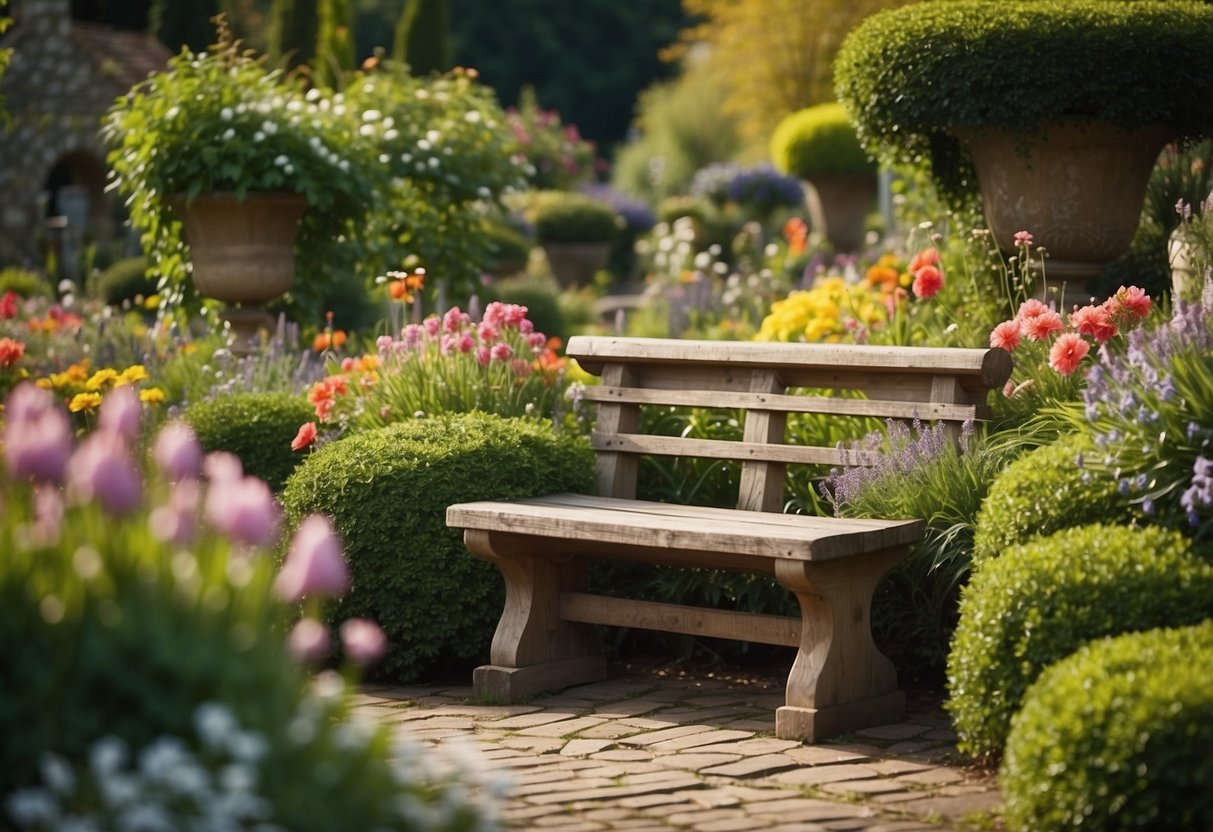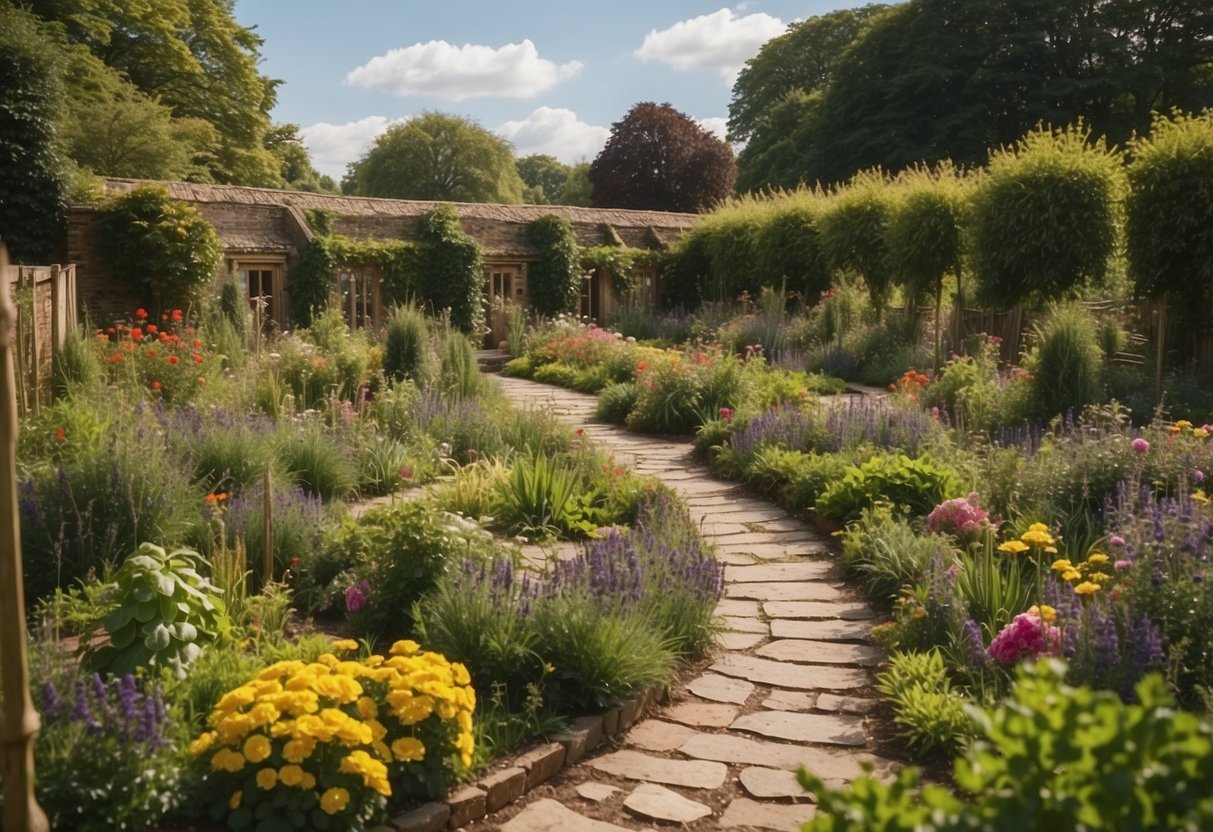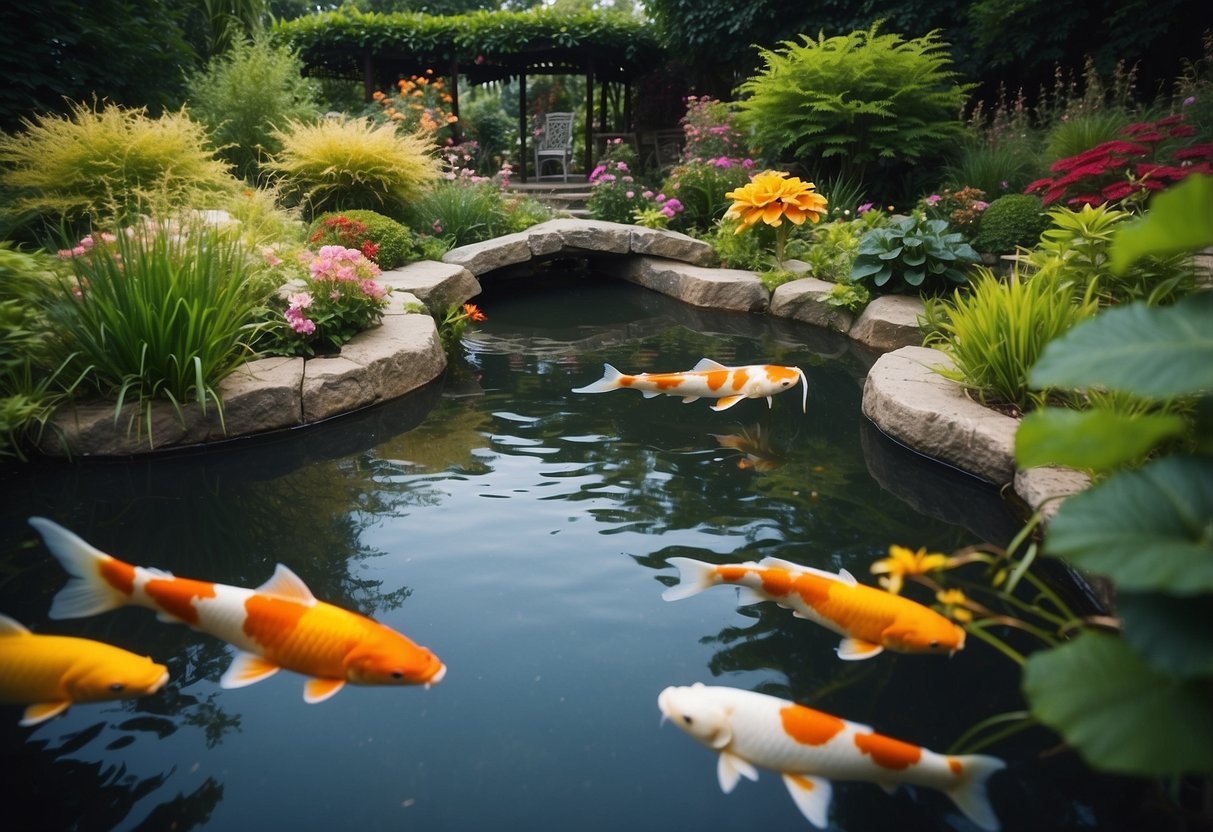English Country Garden Ideas: Charming Designs for Every Yard
Creating an English country garden can transform your outdoor space into a charming and picturesque retreat. With their lush greenery, vibrant flowers, and timeless elegance, these gardens offer a delightful escape from the hustle and bustle of everyday life. The beauty of an English country garden lies in its ability to blend structured design with natural, flowing elements.

What makes an English country garden truly special? It’s the perfect mix of classic and whimsical features that sets it apart. Whether you have a sprawling estate or a cozy backyard, you can find inspiration to create your own version of this beloved garden style.
1) Flowering Cherry Trees

Flowering cherry trees are a beautiful addition to any English country garden. They bloom in spring with lovely pink or white flowers. These trees are perfect for creating a stunning focal point.
Choose varieties like Prunus serrulata ‘Kwanzan’, known for its deep pink double flowers. Another great option is Prunus x yedoensis ‘Somei Yoshino’, which bursts into a spectacular display of pale pink flowers.
To learn how to grow flowering cherry trees, you can follow tips from Gardener’s Path. These trees thrive in full sun and sheltered spots, making them perfect for your garden.
2) Lavender Borders

Lavender borders bring a touch of elegance to any garden. The tall spikes of purple flowers add beauty and fragrance.
Plant lavender along pathways or around garden beds. This can create a stunning visual effect and make your walks through the garden more enjoyable.
Lavender is easy to maintain and can thrive in various soil conditions. It also attracts pollinators like bees and butterflies, adding movement and life to your garden. For more detailed ideas, check out some lavender garden designs.
3) Walled Vegetable Garden

A walled vegetable garden adds charm and functionality to your English country garden. The walls offer protection from wind and pests, creating a microclimate that helps your plants thrive.
In a walled garden, you can grow a variety of vegetables, fruits, and herbs. Consider planting tomatoes, cucumbers, and strawberries along the walls for easy access and a touch of color.
Decorative edging can define different sections or pathways, giving your garden a neat and organized look. Feel free to mix in some flowers for additional beauty.
4) Rose Pergola

A rose pergola can be a stunning addition to your English country garden. You can choose from a variety of roses like ‘Zephirine Drouhin,’ ‘Pearly Gates,’ or ‘New Dawn’ for a range of pink hues.
Place your pergola over a path or seating area to create a charming, fragrant retreat. Regular maintenance will ensure your roses stay healthy and beautiful. Prune them annually and provide adequate support as they grow. You’ll love the romance and elegance they add to your garden.
5) Water Feature with Koi

Adding a water feature with koi to your English country garden brings a serene and lively touch. Koi ponds are not just beautiful but also create a relaxing atmosphere with their soothing water sounds.
A cascading waterfall helps keep the water flowing and filled with oxygen, which is essential for the health of your koi and plants. It also helps prevent algae growth. Adding ornamental plants around the pond enhances its natural look and makes it more attractive.
Get inspired by these koi pond waterfall designs for more ideas.
6) Honeysuckle Trellis

A honeysuckle trellis can bring charm and beauty to your English country garden.
You can choose between a simple wooden trellis, like this small painted one, or a sturdy metal design.
For a larger garden area, consider using a large trellis to create a stunning privacy screen or to cover a wall.
Adding a trellis will not only support your honeysuckle but also add a beautiful vertical element to your garden.
7) Herbaceous Borders

Herbaceous borders bring timeless charm to an English country garden. These areas feature perennials that die back in winter but return each year, adding seasonal interest and structure.
A well-planned herbaceous border can include plants like peonies, delphiniums, and hostas. These plants offer vibrant colors and textures.
To get started, choose a south-facing spot for sun-loving plants or a shaded area for shade-tolerant species. Over time, your border will grow fuller and more beautiful. For more tips, check out these ideas for herbaceous borders.
8) Wildflower Meadow

A wildflower meadow can bring a touch of vibrant, natural beauty to your English country garden. You can include flowers like purple wild marjoram, blue field scabious, and red campion, which add height and color to the space.
Sowing seeds in the fall is best in colder climates. Cooler soil temperatures help the seeds germinate properly as the season shifts.
9) Topiary Box Hedges

Topiary box hedges add a charming and formal element to your English country garden. These evergreen hedges can be clipped into various shapes, from simple squares to intricate designs.
Planting them along pathways creates a structured look. You can also use them to outline garden beds or to form boundaries. Box hedges are versatile and easy to maintain.
For a classic touch, consider shapes like cones or spheres. They provide a neat, tidy appearance and can be as elaborate or simple as you prefer.
10) Climbing Roses

Climbing roses add height and charm to your English country garden. These roses can grow on walls, trellises, and fences.
Consider planting Bridge of Sighs for its lovely peach flowers. It reaches up to 10 feet tall and wide.
St. Swithun roses bloom beautifully and are very hardy. These roses have over 40 petals each and can survive cold weather.
Pair your climbing roses with clematis for a stunning look. The clematis helps cover the stems of the roses, while the roses add fragrance to the garden.
Design Principles for an English Country Garden

Designing an English country garden involves creating a balance between aesthetics and functionality. Focus on symmetry, a harmonious color palette, and integrating local plants to achieve a timeless look.
Balance and Symmetry
Balance and symmetry are key to an English country garden. Use pathways and hedges to create structured layouts. Symmetrical designs often employ mirrored planting, where each half of a garden space is a reflection of the other.
Topiary and parterres complement these arrangements beautifully, adding a sense of order. These elements are not just eye-catching but also guide visitors through the garden in a logical way.
Consider using elements like brick or stone pavers for pathways. These materials bring a formal touch while maintaining the garden’s rustic charm. Creating balanced focal points with garden ornaments like urns or sundials can also enhance symmetry.
Color Palette Choices
Selecting the right color palette is crucial. English country gardens typically use a mix of pastel hues and vibrant colors. Think soft pinks, purples, and whites combined with bolder shades like red and orange.
Using a color theme helps in creating harmony. For example, a white-themed garden could include white roses, lilies, and hydrangeas. Mixing colors should be done thoughtfully to avoid clashing.
Layering plants by height also affects the color presentation. Taller plants at the back and shorter ones in the front allow all colors to be visible. Seasonal blooms add variation and keep the garden colorful throughout the year.
Incorporating Local Flora
Incorporating local flora not only supports local wildlife but also makes garden maintenance easier. Native plants are more likely to thrive and require less care. For instance, in an English country garden, you could use native shrubs like hawthorn or native perennials like foxgloves.
Using local flora blends your garden with the surrounding landscape, creating a seamless natural look. These plants are often more resistant to local pests and diseases.
In addition, local flora attracts local pollinators, contributing to the ecosystem’s health. Including a variety of native plants ensures year-round interest and requires less water and fewer fertilizers. This makes your garden more sustainable and easier to maintain.
By focusing on these design principles, you can create an English country garden that’s both beautiful and practical.
Essential Features in an English Country Garden

Creating an English country garden involves adding key elements like arches, pergolas, pathways, and borders. These features help shape the garden’s look and feel, adding structure and charm.
Arches and Pergolas
Arches and pergolas are must-haves in an English country garden. They create beautiful frames for climbing plants and provide vertical interest to your space. You can use materials like wood or metal to build these structures, depending on your garden’s style and budget.
Flowering arches, such as Laburnum arches at Bodnant Gardens, add a romantic touch and can be a focal point in the garden. Pergolas covered with wisteria or roses also add shade and a place to relax. Incorporating these elements can make your garden feel more intimate and inviting.
Pathways and Borders
Pathways and borders are essential to connect different areas of your garden and define spaces. Traditional English pathways are often made from brick or stone pavers, but you can also use gravel or mulch for a more natural look.
Pathways should be wide enough for easy walking and can guide visitors through various garden “rooms.” Borders lined with colorful perennials and herbs add texture and visual interest. Look for plants with varying heights and colors to create depth and contrast. Mixing in hedges or low walls can also help define spaces and add structure.







